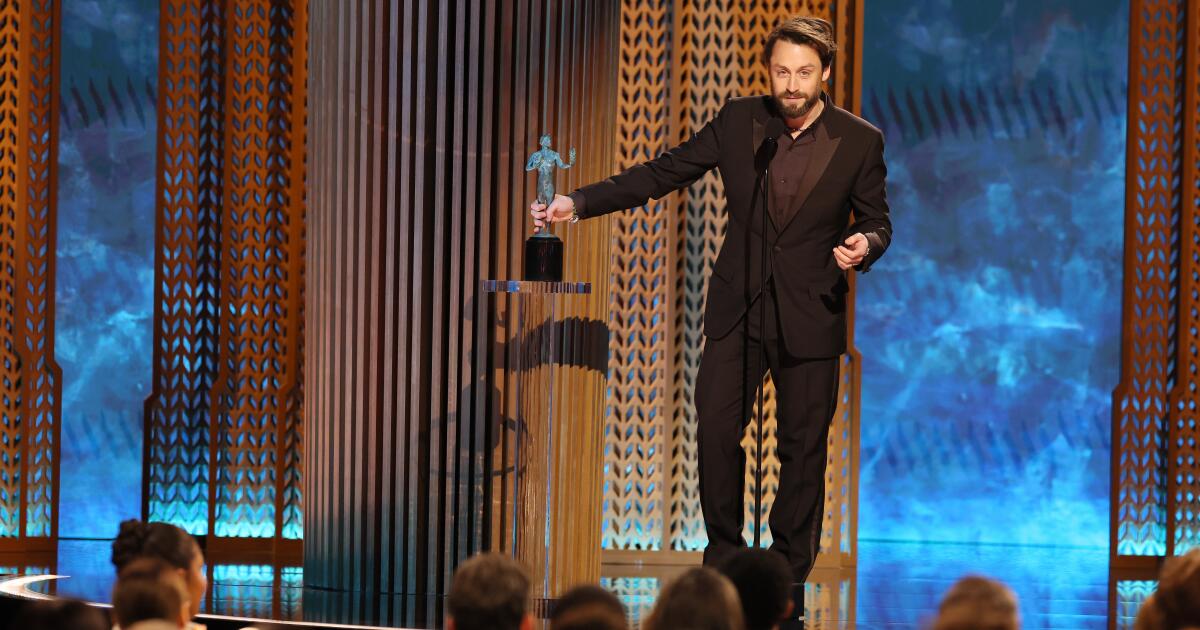
It’s official, Netflix will not be solving the awards-show ratings crisis by turning the Screen Actors Guild Awards into must-watch television.
This year’s SAG Awards opened strongly enough, with a truly funny bit in which “Hacks’” Deborah Vance (Jean Smart) prepared to host the awards only to discover that the reason SAG-AFTRA had been trying so assiduously to contact her was not to request her services but to tell her she hadn’t paid her dues.
This was followed by actual host Kristen Bell singing the delightful ditty “Do You Want to Be An Actor?” (to the tune of “Frozen’s” “Do You Want to Build a Snowman?”) while a montage of early appearances by nominees and others underlined the sometimes ignominious aspects to the acting life.
As the evening’s first winner, for his supporting role in “A Real Pain,” Kieran Culkin kept things moving, commenting on the weight of the award — ”I don’t think anyone could hold this for 45 seconds and that’s your allotted time, Adrien Brody” and what that weight might signify. “It is funny that the heaviest of all awards is given by actors — ’us what we do, it means so much,’” he said, mugging ponderous emotion. “You can see the meeting of actors — ‘it needs more weight.’”
Promising, very promising, but it was all downhill from there.
Which is to say, the show then became precisely what it is — a little more than two hours of famous people giving and receiving awards.
I’m not saying there weren’t entertaining moments. Bits honoring scream queens, “Law and Order: Guest Stars” and actors who got their start in soaps were great fun. In winning for “Baby Reindeer,” Jessica Gunning told fellow nominees Jodie Foster, Kathy Bates and Cate Blanchett that they had been on her dream board when she became an actor, which was very sweet.
Martin Short won best actor in a comedy series (over favorite Jeremy Allen White!) for “Only Murders in the Building,” which would have no doubt yielded a terrifically funny speech except he was not in attendance, (reportedly because he caught COVID at the Saturday Night Live 50th anniversary prime-time special.) Neither was Steve Martin, which left Selena Gomez as the one to thank her co-stars when the show won (over the Emmys-sweeping “The Bear!”) for best ensemble in a comedy series.
Jane Fonda, this year’s Life Achievement Award recipient, did her best to stiffen everyone’s spines for the perilous time that “is coming our way” despite several audio difficulties and, perhaps, a memo warning her not to say the words “Donald Trump.” Los Angeles firefighters and police officers were honored, and contributions to SAG-AFTRA’s fire-relief fund movingly solicited.
At the very end, “Conclave” won best ensemble for a motion picture, which made me very happy.
But it was, over all, fairly boring and more than occasionally lame (Keri Russell and Kerry Washington presented together because, apparently, someone thought that having them say each other’s names several times would be hilarious).
No worse than most awards shows, but no better either.
Netflix’s obvious belief that, despite dwindling ratings for the Oscars, Emmys and Grammys, streaming could take the SAG Awards and make them, well, a star has proved to be misguided.
Everyone deserves to dream, I suppose, but the SAG Awards don’t really need Netflix to make them shine. They’ve always held a special place in awards season as the ceremony with the most stars per square inch (none of those pesky documentary-short makers) and a bellwether for the acting, and perhaps best picture, winners at the upcoming Oscars.
As is inevitably noted in speeches by presenters and winners, the ceremony is deeply personal — a chance for actors to celebrate with, and accept accolades from, their peers, people who understand the difficulties and wonders of being an actor. The ceremony, which is only 30 years old, may be glittering and glamorous, but as a live-television event it was never considered on par with the Oscars, the Emmys or even the Golden Globes.
Netflix, however, thought differently. Last year, after a quarter of a century on TNT and TBS, the SAG Awards moved to the streamer, which seemed to believe that, in the right hands, the form could somehow outshine the function. All it needed was a little zhuzhing up. As in awards delivered during the red (in this case silver) carpet pre-show, backstage interviews with winners and nominees and, of course, no commercials.
But even with these cheeky tweaks, and a splendid speech by Life Achievement Award diva, er, winner, Barbra Streisand, viewership did not climb from the 1.8 million who had tuned in the previous year to TNT/TBS.
This year, the backstage interviews were out, replaced by commercials (which honestly are a necessary force in any awards show, if only to provide snack and bathroom breaks). The awards for stunt work were still given during the pre-show (are those receiving them not famous enough? Discuss). But if you didn’t know you were watching Netflix (and during the pre-show, all those big red Ns made it impossible to overlook), you would have been forgiven for thinking you were watching TNT/TBS.
If Netflix was hoping to prove that streaming is the solution to the dwindling interest in awards show, it did not make its case Sunday night.
The SAG Awards remain as special as they ever were, to those in the room, and those calculating the Oscar odds (see my colleague Glenn Whipp for more details). They don’t need Netflix to make them bigger than that.
Which is good. Because it didn’t.

